Last Updated on January 8, 2024 by Greg Gillson
I’ve put this resource together for you to answer your question: What birds are in my backyard in Virginia?
This article lists and discusses the identification of the most common birds in your backyard. The birds chosen in this article are compiled from actual data from the citizen science program eBird. Thus, it is more accurate than some other similar articles you may find on the web. I provide pictures of each bird species mentioned and I’ll tell how to attract them to your backyard.
These are the most common backyard birds in Virginia:
- Northern Cardinal
- American Crow
- Carolina Wren
- Mourning Dove
- Carolina Chickadee
- Blue Jay
- Tufted Titmouse
- American Robin
- Red-bellied Woodpecker
- American Goldfinch
- Downy Woodpecker
- Song Sparrow
- European Starling
- Northern Mockingbird
- White-breasted Nuthatch
- Eastern Bluebird
- White-throated Sparrow
- House Finch
- Common Grackle
- Red-winged Blackbird
- Eastern Towhee
- Northern Flicker
- Dark-eyed Junco
- Chipping Sparrow
- House Sparrow
- Indigo Bunting
- Red-eyed Vireo
- Gray Catbird
- Barn Swallow
- Eastern Wood-Pewee
- Chimney Swift
Virginia Birds and Birding in Virginia State
eBird lists over 490 types of birds as occurring in the state of Virginia.
The most common bird in Virginia: the most frequently seen bird in the state is Northern Cardinal. It is reported on 59% of bird watching lists.
If you are serious about knowing the birds native to Virginia, then check out eBird for Virginia. It has recent sightings and photos, illustrated checklists with weekly abundance bar charts for state, counties, and individual hotspots of the best birding locations.
If you want to know about other people interested in birds in your area, join a local bird group. The American Birding Association maintains a list of bird watching clubs for each state.
Virginia Bird Identification
This section is the species accounts. These are designed to help you to recognize birds you see in your backyard. I have used eBird to select the birds that are most common. “Common” means the birds seen most often throughout the year, not necessarily the most numerous.
Each species account starts with a photograph. In the identification section I am using size and shape and bill type before considering the color or patterns on the birds. I find these more reliable when trying to identify an unknown bird. Pay attention to body and tail shape and especially bill shape of birds you see, not just plumage color.
In the section on bird feeders and foods I tell how to attract each species. Not all types of backyard birds will come to feeders. But all backyard birds can be attracted with water. So don’t forget to add a birdbath to your bird feeding station.
Do you live in Northern Virginia? Southern Virginia? Eastern Virginia? Central Virginia? Southeast Virgina? Southwest Virginia?
To appear in this article, most birds are widely distributed throughout the state and are often year-round residents. However, for those birds that are more localized in place or time, I list the general region and seasonality. Please see the section following these species accounts for the lists of common species by season.
Even if a species is found in a general area, they occur only in the habitat they prefer. So, the exact habitat of your neighborhood is important for the presence of absence of certain kinds of birds.
1. Northern Cardinal (Cardinalis cardinalis)
This is one of the most common and popular backyard birds in the eastern half of the United States.
 |
| Northern Cardinal. GeorgeB2 from Pixaby |
Range in Virginia: Northern Cardinals are year-round residents throughout Virginia.
Identification:
Size: Cardinals are a bit smaller than American Robins, about the same size as Red-winged Blackbirds.
Shape: Plump body with fairly long full tail. Wispy crest.
Bill: Short, heavy, conical, pink.
Color: That bright red color is matched by few other birds. Black face. The female is grayer, but with hints of red in wings and tail, and has a crest, too.
Habitat, range & behavior: Cardinals are year-round residents in shrubby woodland edges.
They are found from the eastern United States to Texas and Arizona south into Mexico.
That large conical bill is made for chewing seeds. Watch them crack open sunflower seeds, spit out the hulls, and pluck the kernel with their tongues!
Food and feeder preference: Black oil sunflower seeds. Many types of seeds, berries, nuts in larger hopper or tray feeders.
You may like my in-depth article on attracting Northern Cardinals.
2. American Crow (Corvus brachyrhynchos)
This larger all-black bird is common in cities and country. Its cawing call is familiar to most people.
 |
| American Crow. Greg Gillson |
Range in Virginia: American Crows are year-round residents throughout Virginia.
Identification: This is a key species for comparing with an unknown bird.
Size: About 17-1/2 inches long from bill tip to tail tip, though there is much size variation throughout its range. Larger than blackbirds and grackles. Smaller than ravens.
Shape: Thick neck, large head, rather short square-ended tail. Longer legs. In flight has rounded wing tips with each primary feather separated from others forming “fingers.”
Bill: As long as head, thick, black.
Color: Glossy black throughout.
Habitat, range & behavior: They prefer open areas with trees, fields, farms, cities.
They are common across most of the United States lower-48, except in the desert southwest. They move into southern Canada in summer.
They gather in evening communal roosts in large flocks that may number into the thousands and then move out at dawn into the surrounding area.
Food and feeder preference: Omnivorous, they feed on large insects, grain, small mammals, carrion. You probably don’t want these large entirely black birds in your backyard feeders. So don’t feed table scraps to birds.
3. Carolina Wren (Thryothorus ludovicianus)
This is a fairly common backyard bird in the much of the eastern United States.
 |
| Carolina Wren. theSOARnet from Pixabay |
Range in Virginia: Carolina Wrens are year-round residents throughout Virginia.
Identification:
Size: A smaller bird, between the size of American Goldfinch and House Finch.
Shape: Round body, short neck, flat head, long tail flipped about actively.
Bill: Fairly long, thin, pointed and slightly curved.
Color: Upper parts rusty brown with black bars on the wings and tail. A white eyebrow line and buff under parts.
Habitat, range & behavior: Shrubby thickets and brushy suburban yards.
It is found in the southeastern United States and Yucatan. Northern parts of range expand and contract depending upon harshness of winters.
Males sing throughout the year and are very loud for their size.
Food and feeder preference: Feed mostly on insects and spiders. They will feed on suet.
4. Mourning Dove (Zenaida macroura)
Mourning Doves are the most widespread and most frequent backyard bird in the Lower 48 states of the United States.
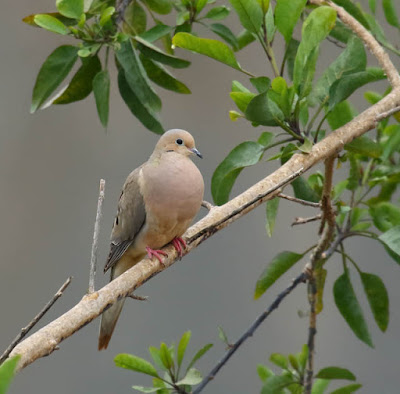 |
| Mourning Dove. Greg Gillson |
Range in Virginia: Mourning Doves are year-round residents throughout Virginia.
Identification: This is a key species for comparing with an unknown bird.
Size: About 12 inches long from bill tip to tail tip. About same size as Northern Flicker. Larger than American Robin. Slightly smaller than domestic city pigeon.
Shape: Very plump with a small round head. Tail is long and pointed. Legs are short.
Bill: Small and rather slender.
Color: Pale brown-pink body, darker wings and tail. White edges on side of tail.
Habitat, range & behavior: Semi-open areas such as urban areas, farmlands, woods. Often seen perched on wires, fences.
It is a resident across the lower-48 states and Mexico, with some movement out of northern areas in winter.
Their mournful cooing is a familiar spring birdsong.
Food and feeder preference: Mourning Doves eat seeds almost exclusively. Attract with black oil sunflower seeds on a large sturdy tray feeder or on the ground.
5. Carolina Chickadee (Poecile carolinensis)
Chickadees are common feeder birds throughout much of North America. This one is common in the southeastern United States.
 |
| Carolina Chickadee. GeorgeB2 from Pixabay |
Range in Virginia: Carolina Chickadees are year-round residents throughout Virginia.
Identification:
Size: This small bid is the size of an American Goldfinch.
Shape: Round body, round head, longer tail.
Bill: Short, straight, stout.
Color: Gray above. Paler below. Black cap, white face, black bib.
Habitat, range & behavior: Lower elevation deciduous forests, wooded residential areas.
This chickadee is a resident in the southeastern US.
Chickadees cannot chew as sparrows do, so they take one large sunflower seed at a time from your feeder and fly off to a branch to pound it open with their stout bills.
Food and feeder preference: Most of their diet is insects, also seeds. They will eat black oil sunflower seeds from hopper feeders.
6. Blue Jay (Cyanocitta cristata)
A common and well-known bird in the eastern half of the United States.
 |
| Blue Jay. skeeze from Pixabay |
Range in Virginia: Blue Jays are year-round residents throughout Virginia.
Identification:
Size: About that of American Robin.
Shape: Fluffy, large crested head, ample tail. Large strong legs.
Bill: Black, long and stout.
Color: Blue above, white below. Black neck collar. White patches in wing.
Habitat, range & behavior: Woodlands and towns.
Found in the eastern half of the United States. In summer into southern Canada. Bold and brash.
May bully smaller birds. Jays gulp lots of seeds or other food at once, storing it in their crop. Then they fly off and bury food items in a hidden cache.
Food and feeder preference: Omnivorous. They can quickly empty your feeder! Because they are also aggressive toward other feeder birds, some people put mesh cages around smaller bird feeders. Small birds can go through, squirrels and larger “pest” birds are prevented entry. Some people feed jays peanuts, perhaps away from the seed feeders.
7. Tufted Titmouse (Baeolophus bicolor)
Related to chickadees, these backyard birds lack the black bib, but have a crest instead.
 |
| Tufted Titmouse. anne773 from Pixabay |
Range in Virginia: Tufted Titmice are year-round residents throughout Virginia.
Identification:
Size: A small bird, but a large titmouse, this species is larger than chickadees, about the size of a junco or House Finch.
Shape: Rounded body, long full tail, big head, long legs.
Bill: Short and stout, compressed (taller than wide), black.
Color: Dark blue-gray above, pale below. Black feathers around eye accentuates its size.
Habitat, range & behavior: Lives in deciduous forests with heavy canopy, parks.
Found in eastern and southeastern United States is expanding its range north and west.
Backyard bird feeders might be helping this species expand its range northward.
Food and feeder preference: Insects and seeds. At your hopper or tray feeder attract with black oil sunflower seeds and suet.
8. American Robin (Turdus migratorius)
This familiar backyard bird is a resident in the northern half of the United States and a common winter visitor in the southern half.
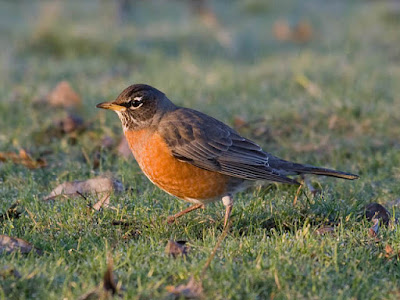 |
| American Robin. Greg Gillson |
Range in Virginia: American Robins are year-round residents throughout Virginia.
Identification: This is a key species for comparing with an unknown bird.
Size: 10 inches long from bill tip to tail tip. About the same size as a Blue Jay or one of the Scrub-Jays. Larger than Red-winged Blackbird. Smaller than a Mourning Dove.
Shape: Very plump with a fairly long tail.
Bill: Straight and fairly slender, curved at the tip.
Color: Gray-brown upperparts, rusty orange breast.
Habitat, range & behavior: Open woodlands, farmlands, urban parks and lawns.
Migratory, breeds north across Alaska and Canada. Resident in most of the United States (lower 48). Winters in the United States, Mexico, to central America.
Hops on your lawn turning head this way and that looking for food. Their caroling song is one of the early signs of spring in the north.
Food and feeder preference: Worms and other invertebrates in the lawn. May eat fruit from a tray feeder or the ground. Eat small berries from trees and bushes.
9. Red-bellied Woodpecker (Melanerpes carolinus)
This is one of the most common species in the eastern half of the United States.
 |
| Red-bellied Woodpecker. skeeze from Pixabay |
Range in Virginia: Red-bellied Woodpeckers are year-round residents throughout Virginia.
Identification:
Size: Fairly large for a backyard bird. Between a Starling and American Robin in size. Smaller than a Northern Flicker.
Shape: Stout with large head and short tail. Clings to tree trunk on strong short legs propped up with short stiff tail.
Bill: Long, chisel shaped.
Color: Pale gray body, many thin black-and-white bars across back and wings. Red nape, extending forward on crown on male.
Habitat, range & behavior: These birds are found in many woodland types, including oak, hickory and pine.
They are found from the eastern slope of the Rocky Mountains in the lower-48 states from Texas to extreme southern Canada, and eastward from Florida northward just to the southern edge of the New England states.
In typical woodpecker fashion, it hitches up the tree trunk and larger branches.
Food and feeder preference: This species eats insects and nuts. They may eat peanuts from a tray feeder and eat from a suet block.
10. American Goldfinch (Spinus tristis)
A beautiful tiny backyard finch familiar to many in its bright yellow summer plumage. Colloquially called a “wild canary.”
 |
| American Goldfinch. Greg Gillson |
Range in Virginia: American Goldfinches are year-round residents throughout Virginia.
Identification: This is a key species for comparing with an unknown bird.
Size: Very small at about 5 inches from bill tip to tail tip. Similar in size to a chickadee. Larger than hummingbirds. Smaller than juncos and House Finches.
Shape: Tiny, somewhat plump with larger head and short tail.
Bill: Short, conical, pink.
Color: Males in summer are bright lemon yellow with black forehead and black wings and tail with white bars. White under tail coverts. Females are dull olive, wings and tail browner. Winter birds are pale grayish-yellow with tan and brown wings and tail.
Habitat, range & behavior: This species is found in weedy fields and similar clearings with thistles and similar plants.
It is found coast-to-coast throughout the year across most of the middle lower-48 states. In summer moves north to the Canada border. In the winter found south to the Mexico border.
The flight is highly undulating, rising and falling as they flap in short bursts. Besides a long, sweet lilting song, they call in flight a lilting 4-part: “potato chip!”
Food and feeder preference: Feeds on weed seeds, thistle seed. May eat black oil sunflower seeds from tube feeder. Love Nyjer seed; attract with a feeder called a “thistle sock.”
You may like my in-depth article on attracting American Goldfinches.
11. Downy Woodpecker (Dryobates pubescens)
This tiny woodpecker is found in backyards across the United States.
 |
| Downy Woodpecker. Greg Gillson |
Range in Virginia: Downy Woodpeckers are year-round residents throughout Virginia.
Identification:
Size: Bigger than a junco or House Finch. Smaller than a Red-winged Blackbird. About the same size as a White-crowned Sparrow, but with a much shorter tail.
Shape: Stocky with large head and short stiff tail.
Bill: Short, chisel shaped.
Color: Black-and-white striped head. Black wings with white spots. Solid white back. White under parts. Black tail with white outer tail feathers with black bars or spots. Male with small red spot at back of head.
Habitat, range & behavior: Found in small deciduous trees, willows, and even weed stocks such as teasel, especially near water.
Ranges coast-to-coast across all but northernmost parts of Canada and Alaska south to the southern US. Absent in the desert southwest.
Interestingly, I learned today that the males may more often be found in smaller plants and twigs, while females are more likely on tree trunks.
Food and feeder preference: Insects, fruits, and seeds. Gleans arthropods from the bark of trees. Attract with suet feeder. Will also eat black oil sunflower seeds.
12. Song Sparrow (Melospiza melodia)
A common bird, but variable, and similar to many other streaked brown sparrows.
 |
| Song Sparrow. Greg Gillson |
Range in Virginia: Song Sparrows are year-round residents throughout Virginia.
Identification:
Size: A smaller bird, similar in size to House Finch and juncos. Larger than chickadees and goldfinches. Smaller than White-crowned Sparrows or Spotted/Eastern towhees.
Shape: Plump with round head, long rounded tail.
Bill: Short, conical.
Color: Highly variable in darkness and color saturation across its range (dark rusty to pale gray). Generally gray-brown above with dark brown streaking on back. Complicated head pattern. Streaking on sides and breast converge into dense central breast spot.
Habitat, range & behavior: Thickets, especially near water. Backyard shrubbery.
Resident in western United States, western Canada, coastal southern Alaska, northeastern US. In summer also moves into mid-Canada and northern half of US. In the winter found in most of the US lower-48. Also, a population in central Mexico.
Forages on ground, never far from low cover to which they fly if startled.
Food and feeder preference: They feed on seeds and insects near the ground. Will visit hopper and tray feeders for mixed bird seed.
13. European Starling (Sturnus vulgaris)
Introduced to North America in the late 1800’s, they crossed the continent, often to the detriment of native cavity-nesting birds. The prime example of an invasive species.
 |
| European Starling. Greg Gillson |
Range in Virginia: European Starlings are year-round residents throughout Virginia.
Identification: This is a key species for comparing with an unknown bird.
Size: 8-1/2 inches from bill tip to tail tip. About the size of a Red-winged Blackbird. Smaller than an American Robin. Larger than a White-crowned Sparrow or Spotted/Eastern towhee.
Shape: Stocky with large head, short square-ended tail. Longer legs.
Bill: As long as head. Sharp pointed. Yellow in spring, otherwise dark.
Color: They are grayish brown much of the year, with glossy iridescence and white spotting during the spring.
Habitat, range & behavior: Lowland birds that need trees large enough for nest cavities but plenty of open area for feeding. They are most abundant in urban and suburban areas where they find food and artificial nest cavities.
Resident from coast-to-coast from southern Canada to northern Mexico. In summer north across Canada and Alaska. Native range is Europe to Pakistan, north Africa.
Often viewed as a pest, starlings often bully other backyard birds, taking over bird feeders, and stealing nest cavities from smaller native birds. In winter they can form into flocks of tens of thousands.
Food and feeder preference: Primarily insects when available, often feeding on the ground. Discourage them from your backyard hopper and tray feeders by never feeding birds table scraps (including bread or meat). They have weak feet and do not perch well on tube feeders. A cage mesh around smaller hopper feeders may keep them out.
14. Northern Mockingbird (Mimus polyglottos)
This bird sings from exposed perches most of the year and often through the night. They have an unending supply of their own unique short phrases that they repeat about 3 times each, but frequently intersperse songs of other birds.
 |
| Northern Mockingbird. Greg Gillson |
Range in Virginia: Northern Mockingbirds are year-round residents throughout Virginia.
Identification:
Size: The length of an American Robin.
Shape: Slender and long tailed. Long legs.
Bill: Medium length, slender, slightly curved.
Color: Gray, darker above, with white patches in wing and tail.
Habitat, range & behavior: They prefer edge habitat with scattered trees and bushes, parks and residential areas.
It is found in eastern and southern parts of the US, West Indies, and south into Mexico. In summer birds are found a bit farther north.
They boldly defend their nests from other birds, cats, and intruders.
Food and feeder preference: Eats insects, berries, and fruit. You may attract mockingbirds to your feeder with grapes, raisins, apple slices. They will come to a suet block. They readily use a bird bath.
15. White-breasted Nuthatch (Sitta carolinensis)
A favorite backyard feeder bird for many for its active antics and fearlessness. Though a small bird it is the largest nuthatch in North America.
 |
| White-breasted Nuthatch. Greg Gillson |
Range in Virginia: White-breasted Nuthatches are year-round residents throughout Virginia.
Identification:
Size: About chickadee-sized in length. Smaller than a junco or House Finch.
Shape: Appears large-headed, neckless, very short tailed. Short legs.
Bill: Nearly as long as head, straight, thin.
Color: Blue-gray above, white below. Black cap, wing tips, tail. Rusty feathers under tail.
Habitat, range & behavior: Common in oak and oak-pine woodlands, wooded towns.
Found across the United States, southern Canada, mountains of central Mexico. Absent from treeless grasslands, deserts in the west.
Crawls over tree branches and head-first down tree trunks searching for insects.
Food and feeder preference: Insects, seeds, acorns and other nuts. Attract with black oil sunflower seeds feeding on hopper and tray feeders. Suet blocks.
16. Eastern Bluebird (Sialia sialis)
A beloved bird of open fields with trees and fence lines for perching.
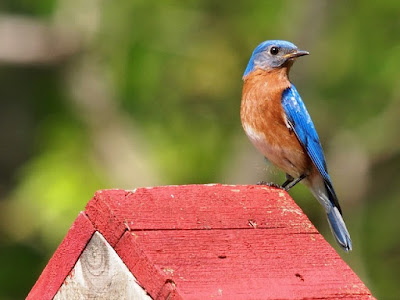 |
| Eastern Bluebird. skeeze from Pixabay |
Range in Virginia: Eastern Bluebirds are year-round residents throughout Virginia.
Identification:
Size: Larger than House Finches. Much smaller than starlings. About length of White-crowned Sparrow but differently proportioned.
Shape: Chunky, large head, short tail.
Bill: Straight, fairly slender, curved at tip.
Color: Males are brilliant blue above (including wings and tail), rusty orange below with white belly and under tail. Females are often much paler, almost grayish.
Habitat, range & behavior: Found in pasture, fields, golf courses, open woodland edges.
They are resident in most of eastern US, highlands of Middle America. In summer reach northernmost eastern US and southernmost eastern Canada, withdrawing somewhat in winter.
They readily use nest boxes, but the entrance hole must be smaller than the head of a starling, and without a perch.
Food and feeder preference: They eat flying insects primarily, but also other invertebrates and berries. They will eat mealworms at your feeder and frequent birdbaths.
17. White-throated Sparrow (Zonotrichia albicollis)
A fairly common bird of northern forests that visits backyards across much of the US.
 |
| White-throated Sparrow. Greg Gillson |
Range in Virginia: White-throated Sparrows are winter visitors throughout Virginia.
Identification:
Size: Similar in size to White-crowned Sparrow. Bigger than a House Finch; smaller than a starling.
Shape: Longer body. Round head on short neck. Long tail with notched tip.
Bill: Short. conical.
Color: Striped tan and brown above, pale gray below. White-striped form with black and white head stripes. Tan-striped form with tan and brown striped head. First year birds are similar to tan-stiped adults, but streakier overall. Yellow spot between eyebrow and bill. White throat strongly offset from gray breast and face.
Habitat, range & behavior: Found in forests, brush, and open woodland edges.
Breeds across Canada and northernmost Eastern United States. Winters in the eastern US, southern central US, and rare but regular along the West Coast.
Found in small flocks on ground near brush into which they can flee. Kick up leaves to search under for food.
Food and feeder preference: Eat seeds and berries in winter, more insects and fruit in summer. In your feeder will eat mixed seeds on a platform feeder and on the ground.
18. House Finch (Haemorhous mexicanus)
Originally a bird of the West, now found across most of the US. There are other red finches, but these are the ones most likely in residential areas.
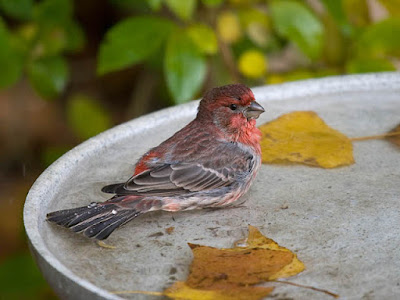 |
| House Finch. Greg Gillson |
Range in Virginia: House Finches are year-round residents throughout Virgina.
Identification: This is a key species for comparing with an unknown bird.
Size: About 6 inches from bill tip to tail tip. Larger than goldfinches and chickadees. Smaller than a White-crowned Sparrows or Spotted/Eastern towhees.
Shape: Medium build with a medium-long notched tail. Round head.
Bill: Short, conical.
Color: Brown and gray above with streaks on the sides of the pale underparts. Males with red (sometimes orange or rarely yellow) crown, chest, rump.
Habitat, range & behavior: You’ll find small flocks on wires, in short treetops and in bushes. Originally deserts and grasslands. Rural areas and towns are where they’re now most common.
Formerly found in the western United States and Mexico. Then introduced into the northeastern United States, but now found in nearly all of the lower-48 states and extreme southern Canada. Rare in plains states (Dakotas to Texas) and southern Florida.
House Finches are not territorial, but males sing throughout the year–a lively, wiry song ending in a couple of buzzy notes.
Food and feeder preference: They love sunflower seeds. Attract with black oil sundlower seeds and tube feeders. May eat from thistle socks.
You may like my in-depth article on attracting House Finches.
19. Common Grackle (Quiscalus quiscula)
Sometimes considered a pest to crops, grackles are longer and lankier than very similar blackbirds.
 |
| Common Grackle. GeorgiaLens from Pixabay |
Range in Virginia: Common Grackles are year-round residents throughout Virginia.
Identification:
Size: Larger than Red-winged Blackbirds, they are near the length of Mourning Doves.
Shape: Long, with long full keel-shaped tail, long legs, flat crown.
Bill: Longer than head, pointed, but stouter than other blackbirds.
Color: Glossy black with hint of bronze or green on head (depending upon population). Yellow eye.
Habitat, range & behavior: They are found in agricultural areas, woodland edges, city parks and lawns.
Resident in the southeastern United States. In summer they migrate northward and west to the central United States and Canada.
They monopolize feeders and are bullies toward other birds.
Food and feeder preference: Grain, corn, acorns, small aquatic fish and amphibians. To discourage them, use tube feeders, rather than hopper or tray feeders. Don’t over-feed, keep spilled seed picked up.
20. Red-winged Blackbird (Agelaius phoeniceus)
These noisy flocking birds are most often found in marshes. But in winter they are found in backyards.
 |
| Male Red-winged Blackbird. Greg Gillson. |
 |
| Female Red-winged Blackbird. Greg Gillson. |
Range in Virginia: Red-winged Blackbirds are year-round residents throughout Virginia.
Identification: This is a key species for comparing with an unknown bird.
Size: About 8-3/4 inches long from bill tip to tail tip. About the size of a Northern Cardinal. Smaller than an American Robin.
Shape: Pot-bellied with a longer bill and flat forehead. Tail average.
Bill: Long and sharp pointed.
Color: Males are black with red and yellow shoulder patch. Females are streaked brown and rusty (sparrow-like but pointed bill and flat forehead).
Habitat, range, and behavior: Cattail marshes and wetlands are their summer habitat. In winter they feed in grain fields.
They breed across most of the North American continent. In winter they withdraw from most of Alaska and Canada.
They are found in colonies in summer and large flocks in winter.
Food and feeder preference: They eat insects in summer. In winter they eat grain and seeds. They visit feeders, more often in large winter flocks, and eat most seeds and suet.
21. Eastern Towhee (Pipilo erythrophthalmus)
These birds were formerly lumped with Spotted Towhee as one species, Rufous-sided Towhee. Together they were found across the United States, they now split the country in half, east and west.
 |
| Eastern Towhee. Skeeze from Pixabay. |
Range in Virginia: Eastern Towhees are year-round residents throughout most of Virginia, summer residents only in the higher mountains in the northwestern part of the state.
Identification:
Size: Just a bit larger than a White-crowned Sparrow.
Shape: Chunky or pot-bellied with a big round head and full rounded tail.
Bill: Stout and conical.
Color: Black hood and upper parts, including tail. White wing path. White tail corners. Rusty sides. White belly. Females replace the black with dark brown.
Habitat, range & behavior: Brushy woodland edges. Tangles.
Breeds throughout the eastern United States and adjacent southernmost Canada. Northern populations migrate out of the northern US to the Southeast.
These birds spend much of their time on the ground, kicking up leaf litter with both feet in a hop-kick.
Food and feeder preference: These birds eat a wide variety of insects, beetles, berries, and seeds. They will feed on the ground under your feeder or on platform feeders. They like black oil sunflower seeds and other seeds.
22. Northern Flicker (Colaptes auratus)
Of all the bird identification questions I get asked, this common larger backyard bird is the bird most people ask about. It doesn’t occur to those unfamiliar with it that this could be a woodpecker.
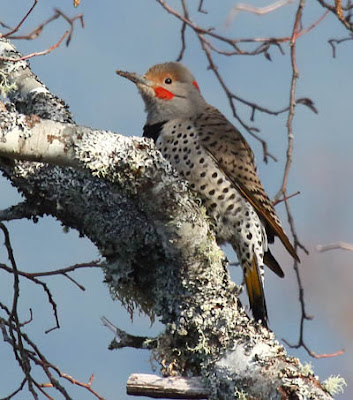 |
| Northern Flicker. Greg Gillson. |
Range in Virginia: Northern Flickers are year-round residents in Virginia.
Identification:
Size: About the size of a Mourning Dove. Larger than a robin.
Shape: Stocky with short legs, short tail, big head.
Bill: As long as head, thin, slightly curved.
Color: Back is brown with black bars. Under parts pinkish with black spots. Undersides of black wing and tail feathers are bright salmon red (West) or yellow (East). Head gray (West) or brown (East) and males with red (West) or black (East) whisker marks and nape marks (East). Black crescent across chest. White rump seen in flight.
Habitat, range & behavior: Found in woodland edges and forests.
Year-round resident from extreme southern Canada, across all of the lower-48 states and in the mountains of Mexico and Middle America. In summer breeds northward well into Canada and Alaska.
Frequently noted hopping on ground pecking in the ground for insects. In late spring, males proclaim their territory by rapid pounding on a hollow tree branch, though the ringing of metal downspouts at dawn is louder and carries much farther, to the exasperation of anyone trying to sleep inside!
Food and feeder preference: Ants and beetles are their primary foods. Will eat black oil sunflower seeds and are attracted to suet.
23. Dark-eyed Junco (Junco hyemalis)
Colloquially called “snowbirds,” they often arrive in backyards in winter from nearby mountain forests or more northern climes.
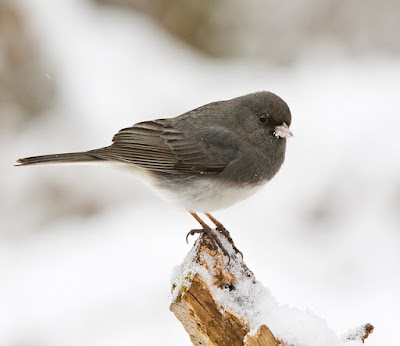 |
| Dark-eyed Junco. skeeze from Pixabay |
Range in Virginia: Dark-eyed Juncos are winter visitors throughout Virginia, a few are found year-round along the extreme western border of the state.
Identification:
Size: Small birds about the size of House Finch.
Shape: Round body, short neck, round head, fairly long square-ended tail.
Bill: Short, pointed, conical, pink.
Color: Eastern birds are a darker all-gray with white belly. Western birds have jet black hood over their head, brown back, and pink sides.
Habitat, range & behavior: Breed in coniferous forests. Winters widely. Avoids heavy brush, preferring widely spaced bushes.
Breeds across most of Canada, Alaska, and the western half of the United States. Winters from southern Canada and all of the lower 48-states to extreme northern Mexico.
Spend much of their time hopping and feeding on the ground.
Food and feeder preference: Eats mostly seeds, also insects in summer. Readily feed at backyard feeders on mixed seeds on hopper or tray feeders and ground.
You may like my in-depth article on attracting Dark-eyed Juncos.
24. Chipping Sparrow (Spizella passerina)
Chipping Sparrows are a widespread species adapted to human disturbance. They are rather tame. They are frequently found in cemeteries with large trees.
 |
| Chipping Sparrow. Greg Gillson. |
Range in Virginia: Chipping Sparrows are summer residents throughout Virginia, they are year-round residents in the southeastern part of the state.
Identification:
Size: These are small sparrows, bigger than goldfinches or chickadees, but smaller than House Finches or Song Sparrows.
Shape: Plump and fairly long tailed.
Bill: Short and conical.
Color: Striped brown and dark brown above. Grayish under parts. Black line through eye. Crown streaked in winter but in summer becomes solid chestnut. Two white wing bars.
Habitat, range & behavior: Grassy open conifer woodlands with some shrubs, parks, orchards.
Breeds from Alaska, across Canada and south into highlands of Middle America. In winter retreats from northern areas to southern United States and northern Mexico.
In summer solitary or in pairs. In winter they forage in flocks of up to 50 birds.
Food and feeder preference: Weed seeds, supplemented with insects in summer. They may eat black oil sunflower seeds in your feeder, but more likely will feed on mixed seeds on the ground under the feeder.
25. House Sparrow (Passer domesticus)
Like the starling, this is another bird introduced from Europe in the 1800’s. This sparrow is commonly found in cities and farmlands. It is considered a pest in most areas where it has been introduced.
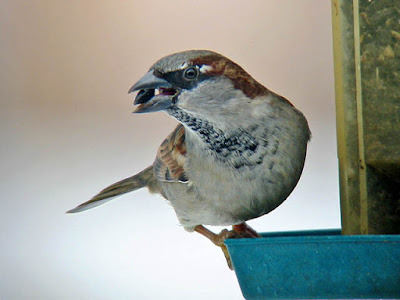 |
| House Sparrow. Greg Gillson |
Range in Virginia: House Sparrows are year-round residents throughout Virginia.
Identification:
Size: The size of a House Finch or Dark-eyed Junco.
Shape: Chunkier than native North American sparrows with large head, barrel chest, short neck, medium tail, short legs.
Bill: Short, conical.
Color: Males are brown and gray with a black mask. Females lack the black and are tan and brown with a pale line back from the eye.
Habitat, range & behavior: Cities and farms.
Range in North American from southern Canada through Central America. In summer northward through Canada to southern Alaska. Originated in Middle East and spread to most of Europe and Asia. Introduced in South America, Africa, Australia–nearly anywhere there are people and cities.
They tend to be messy… and have a good appetite and may occur in large noisy chirping flocks. They are aggressive toward other feeder birds.
Food and feeder preference: They eat grain, seed, and insects. To discourage them from your hopper and tray feeders do not feed birds human food scraps. They have a bit of difficulty eating from tube feeders.
26. Indigo Bunting (Passerina cyanea)
Don’t mistake Indigo Buntings for the larger Blue Grosbeak. As the name suggests, the grosbeak has a much larger and thicker bill, along with rusty wing bars, lacking in Indigo Buntings.

Range in Virginia: Indigo Buntings are summer residents throughout Virginia.
Identification:
Size: These birds are a bit smaller than a House Sparrow.
Shape: Plump. Large round head. Medium short tail.
Bill: Large and conical.
Color: Males are deep blue. Females are pale gray-brown with diffuse streaks below.
Habitat, range & behavior: Open woodlands and clearings. Country farm roads.
They are found in the East and parts of the Southwest, north to southern Canada.
Sing from the tallest tip of tree or telephone lines, a cheerful paired bouncy song very similar to American Goldfinch. In fact, they are sometimes called “blue goldfinches” because of this!
Food and feeder preference: These birds will eat seeds from hopper feeders, perhaps more so in the late spring when they first arrive during migration.
27. Red-eyed Vireo (Vireo olivaceus)
This is one of the most common songbirds in eastern woodlands.

Range in Virginia: Red-eyed Vireos are summer residents throughout Virgina.
Size: Small, about the size of an American Goldfinch. Smaller than a House Finch.
Shape: Long and slim, but with rather short tail. Big-looking head.
Bill: Longer, stout. Pointed but small hook on the end, as all vireos.
Color: They are olive-green above, white or with a hint of yellow below. Gray crown, bordered bp>y black line, white eyebrow, and another thin black line through red eye.
Habitat, range & behavior: Tall deciduous trees, such as cottonwoods.
Breed across Canada, the Rocky Mountains and most of the East. Absent from much of the West and Southwest.
As with many vireos, they sing persistently through the summer and through the heat of the day, not just primarily during spring and at dawn as many other songbirds.
Food and feeder preference: They eat insects and will not come to feeders.
28. Gray Catbird (Dumatella carolinensis)
This bird is rather common where it occurs, but a bit secretive.

Range in Virginia: Gray Catbirds are summer residents throughout Virginia, they are year-round residents in the eastern lowlands.
Identification:
Size: About the length of a Red-winged Blackbird or Northern Cardinal.
Shape: Long tailed, round head.
Bill: Medium length, pointed.
Color: Gray with a black tail and black cap. Rusty under tail coverts.
Habitat, range & behavior: Dense woodland edges, scrub, abandoned orchards.
Breeds in eastern and central US and adjoining southern Canada. Winters in extreme south US Gulf states, southward in eastern Mexico to Panama.
They spend much time hopping on the ground or in low bushes. They defend a winter territory, unlike most birds.
Food and feeder preference: Insects and berries. You may attract this species with jelly and fruit feeders, suet, and water.
29. Barn Swallow (Hirundo rustica)
These swallows are widely distributed throughout the world, primarily breeding in the northern hemisphere, and wintering in the mid-latitudes and southern hemisphere.
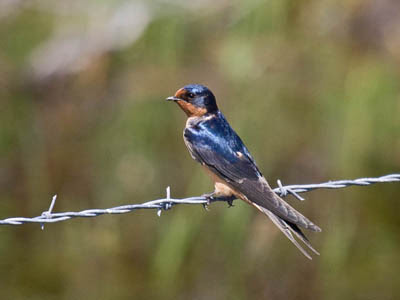 |
| Barn Swallow. Greg Gillson. |
Range in Virginia: Barn Swallows are summer residents throughout Virginia.
Identification:
Size: About the size of a House Finch but with a much longer tail.
Shape: Stocky, short necked but with long body and tail. Tail is forked, with very long outer tail feathers. Wings pointed.
Bill: Short, wide.
Color: Glossy dark purplish-blue above. Pinkish-orange below.
Habitat, range & behavior: Barn Swallows live in open country, frequently near humans. Farmlands. Nest in barns, under small bridges.
In North America breed from Mexico to northern Canada and Alaska, wintering from southern Mexico throughout most of South America.
Frequently seen swooping low over the ground hunting flying insects. Perch on wires, fences. Voice is twitters and chirps with grating sounds.
Food and feeder preference: Eat flying insects on the wing and are not attracted to backyard feeders.
30. Eastern Wood-Pewee (Contopus virens)
Eastern Wood-Pewees and Western Wood-Pewees appear very similar. Their ranges nearly split the continent in half, east and west. Their song separates them; it is a clear whistled pee-a-wee in the Eastern Wood-Pewee, and a burry pee-yeear in the Western Wood-Pewee.
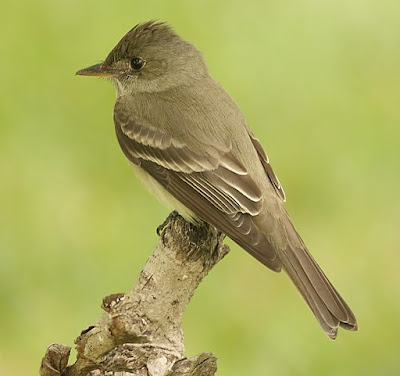 |
| Eastern Wood-Pewee. Tony Castro CC 4.0 |
Range in Virginia: Eastern Wood-Pewees are summer residents throughout Virginia.
Identification:
Size: Bigger than a House Finch; smaller than a bluebird.
Shape: Upright posture. Large head. Thick chest. Long tail. Long wings.
Bill: Medium length, wide at base. Black above; yellow-orange below.
Color: Grayish-olive above, slight yellow tinge below (looks white in strong light). Pale wing bars. No eye ring.
Habitat, range & behavior: Woodlands. Large shade trees in town.
Summer resident in the East, from southern Canada southward.
These flycatchers tend to perch on a dead twig high in the canopy. They sing throughout the day, attracting attention to this otherwise quite drab and nondescript bird.
Food and feeder preference: These birds feed on flying insects and do not come to feeders.
31. Chimney Swift (Chaetura pelagica)
Swifts have such small weak feet that they cannot perch on wires or trees like swallows. Look for them high in the air chasing bugs with rapid wingbeats.
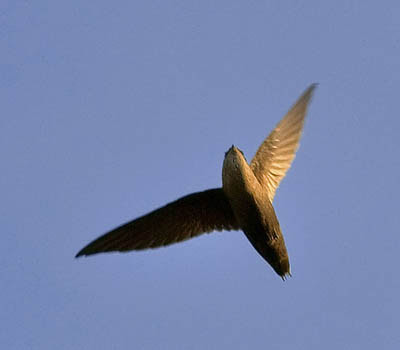 |
| Chimney Swift. Jim McCulloch CC 2.0 |
Range in Virginia: Chimney Swifts are summer residents throughout Virginia.
Identification:
Size: Small bird. Smaller than House Finches or Cliff Swallows.
Shape: Small head on short neck, very short tail. Thin pointed wings with no apparent bend at the wrist as most other birds.
Bill: Very short, wide.
Color: Gray-brown throughout.
Habitat, range & behavior: Open sky, above forests or residential areas.
They are summer residents east of the Rockies from southern Canada southward. They do not winter in the United States.
In fall migration they form large flocks of hundreds or thousands and swirl into large chimneys at dusk. Because the upper arm is so short as to barely exist, the flight of swifts is described as rapid and twinkly, not smooth and graceful as swallows.
Food and feeder preference: Insects caught on the wing. Will not visit feeders.
Common Birds in Virginia
To determine how common each species is I used the data from actual bird sightings from the citizen science program eBird. Birds are listed by frequency. That is, how often the species is recorded on checklists submitted to eBird (a percentage).
When choosing the birds to include in this article I leaned strongly to birds that are present throughout the year in good numbers. Thus, many of the common birds are year-round residents. This means that they live in the same location all year. They raise their young in your neighborhood. They don’t migrate. Or if the species does migrate, the ones living in your area don’t. If this is the case, some migrants may move into your area during certain times of year, adding to the same species that are in your yard full time.
Some migrant birds visit your yard during the “summer.” Often, they arrive in spring and remain until late fall. They nest and raise their young in your neighborhood. These are the summer residents.
Other migrant birds visit your backyard during the “winter.” Some of these winter visitors may arrive in July and remain into April. Others may only be found in the cold of December or January. They key here is that they nest and raise their young somewhere else. They only visit your yard in the non-breeding season.
Migration is an amazing spectacle.
There will be birds that fly through your region in spring or fall (or both). They may visit your backyard only a few days or weeks a year. They aren’t regular enough, or stay long enough, to be included in this article. But the number of briefly visiting migrant birds could double the number of species presented here. You may see them over time. Consult checklists in eBird for your county to see what is possible.
I have generally excluded common waterfowl, birds of prey, shorebirds, seabirds, and others that aren’t usually found in residential areas. But they may certainly fly over or be seen regularly if your home is on a shoreline, for instance.
Most common backyard birds in Virginia throughout the year
The following list is the backyard birds that are, on average, most common throughout the entire year. The list is ordered by most common based on the frequency of how often each species is recorded on checklists submitted to eBird.
The most common backyard birds throughout the year in the state of Virginia, in order, are these:
- Northern Cardinal (59% frequency)
- Carolina Wren (48%)
- American Crow (46%)
- Mourning Dove (42%)
- Carolina Chickadee (42%)
- Blue Jay (42%)
- Tufted Titmouse (39%)
- American Robin (39%)
- Red-bellied Woodpecker (37%)
- American Goldfinch (34%)
- Downy Woodpecker (32%)
- Song Sparrow (31%)
- European Starling (29%)
- Northern Mockingbird (27%)
- Eastern Bluebird (27%)
- White-breasted Nuthatch (26%)
- White-throated Sparrow (25%)
- House Finch (25%)
- Common Grackle (21%)
- Red-winged Blackbird (20%)
- Eastern Towhee (17%)
- Northern Flicker (17%)
- Dark-eyed Junco (17%)
- Chipping Sparrow (16%)
- House Sparrow (16%)
Most common backyard birds in Virginia in winter
- Northern Cardinal (55% frequency)
- Carolina Chickadee (44%)
- Carolina Wren (44%)
- American Crow (43%)
- White-throated Sparrow (40%)
- Tufted Titmouse (39%)
- Blue Jay (37%)
- Red-bellied Woodpecker (37%)
- Mourning Dove (36%)
- Dark-eyed Junco (35%)
- Downy Woodpecker (35%)
- Song Sparrow (34%)
- White-breasted Nuthatch (29%)
- American Goldfinch (28%)
- American Robin (28%)
- European Starling (27%)
- House Finch (27%)
- Eastern Bluebird (25%)
- Northern Mockingbird (23%)
Most common backyard birds in Virginia in summer
- Northern Cardinal (60% frequency)
- Carolina Wren (48%)
- Mourning Dove (47%)
- American Robin (44%)
- American Crow (43%)
- American Goldfinch (39%)
- Tufted Titmouse (35%)
- Blue Jay (35%)
- Indigo Bunting (33%)
- Common Grackle (31%)
- Carolina Chickadee (31%)
- Northern Mockingbird (30%)
- Red-eyed Vireo (29%)
- Red-bellied Woodpecker (28%)
- European Starling (27%)
- Song Sparrow (27%)
- Chipping Sparrow (27%)
- Barn Swallow (24%)
- Gray Catbird (26%)
- Eastern Bluebird (27%)
- Eastern Towhee (25%)
- Downy Woodpecker (25%)
- Red-winged Blackbird (25%)
- House Finch (24%)
- Eastern Wood-Pewee (24%)
- Chimney Swift (20%)
- White-breasted Nuthatch (20%)
How do birds differ between seasons?
In winter Carolina Chickadees, White-throated Sparrows and Dark-eyed Juncos are more common.
In summer American Robins, American Goldfinches, Indigo Buntings, Common Grackles, Northern Mockingbirds, Red-eyed Vireos, Chipping Sparrows, Barn Swallows, Gray Catbirds, Eastern Towhees, Eastern Wood-Pewees and Chimney Swifts are more common.
Common Backyard Birds of Virginia Beach, Virginia
 |
| American Crow. Greg Gillson |
The common backyard birds of Virginia Beach, Norfolk, Hampton Roads, and Chesapeake are all very similar.
- Northern Cardinal (41% frequency)
- American Crow (38%)
- Carolina Chickadee (34%)
- Carolina Wren (33%)
- Yellow-rumped Warbler (27%) Learn about this species on eBird
- Mourning Dove (25%)
- American Robin (25%)
- Northern Mockingbird (25%)
- Red-winged Blackbird (24%)
- Blue Jay (21%)
- Song Sparrow (20%)
- European Starling (20%)
- Red-bellied Woodpecker (20%)
The coastal influence is obvious. Many coastal waterbirds are quite common and may be seen from or flying over your backyard.
Many common species in the state as a whole are not nearly as commonly reported in Virginia Beach. These include Tufted Titmice, Red-bellied Woodpeckers, American Goldfinches, Downy Woodpeckers, European Starlings, and several others. This may actually be a reflection of the more visited coastal habitat, where more bird lists are submitted to eBird for coastal locations than backyards.
Yellow-rumped Warblers are more common in the Virginia Beach area than in the rest of the state, on average.
Common Backyard Birds of Richmond, Virginia
- Northern Cardinal (63% frequency)
- Carolina Wren (48%)
- American Crow (46%)
- Tufted Titmouse (45%)
- Mourning Dove (45%)
- American Goldfinch (37%)
- Chipping Sparrow (36%)
- Red-bellied Woodpecker (34%)
- Blue Jay (32%)
- White-throated Sparrow (32%)
- Eastern Bluebird (31%)
- Carolina Chickadee (31%)
- Red-winged Blackbird (28%)
- Brown-headed Cowbird (25%) Learn about this species on eBird
- Downy Woodpecker (25%)
- Common Grackle (24%)
- Northern Mockingbird (23%)
- Dark-eyed Junco (23%)
- House Finch (23%)
Carolina Chickadees, Blue Jays and American Robins are less common in Richmond than the average for Virginia as a whole.
Chipping Sparrows, White-throated Sparrows, and Brown-headed Cowbirds are more common in Richmond than in the state as a whole.
Common Backyard Birds of Fredericksburg and Alexandria, Virginia
- Northern Carolina (66% frequency)
- American Crow (48%)
- American Robin (47%)
- Carolina Chickadee (46%)
- Mourning Dove (45%)
- Carolina Wren (44%)
- Tufted Titmouse (40%)
- Blue Jay (40%)
- European Starling (39%)
- Song Sparrow (39%)
- House Finch (38%)
- White-throated Sparrow (34%)
- Northern Mockingbird (32%)
- Red-bellied Woodpecker (31%)
- Downy Woodpecker (31%)
- American Goldfinch (29%)
- Dark-eyed Junco (28%)
- Eastern Bluebird (26%)
- House Sparrow (25%)
- Yellow-rumped Warbler (23%) Learn about this species on eBird
- Common Grackle (23%)
- Fish Crow (21%) Learn about this species on eBird
American Robins, European Starlings, Fish Crows, and House Sparrows are a bit more common in the Fredericksburg area than the state average.
Other backyard birds are quite similar in abundance and make-up to the state average.
Common Backyard Birds of Roanoke, Virginia
- Northern Cardinal (65% frequency)
- American Crow (61%)
- Carolina Wren (56%)
- Carolina Chickadee (55%)
- Blue Jay (54%)
- Tufted Titmouse (50%)
- American Goldfinch (44%)
- Mourning Dove (44%)
- Song Sparrow (43%)
- Eastern Bluebird (42%)
- Red-bellied Woodpecker (41%)
- Downy Woodpecker (39%)
- American Robin (38%)
- House Finch (38%)
- White-breasted Nuthatch (37%)
- Northern Mockingbird (31%)
- White-throated Sparrow (26%)
- European Starling (24%)
- Chipping Sparrow (23%)
- Eastern Phoebe (22%) Learn about this species on eBird
Song Sparrows, Eastern Bluebirds, White-breasted Nuthatches, and Eastern Phoebes are a bit more common in Roanoke than average for the state of Virginia as a whole.
Wrapping Up
If you are feeling adventurous and want to explore Virginia past the backyard, there are some amazing parks to visit. They boast everything from waterfowl to raptors and are easily accessible.
Water birds:
- Great Blue Heron: Standing tall and regal along rivers and lakes, these large wading birds with long necks and blue-grey plumage often fish for prey.
- Canada Goose: Honking flocks of these large migratory geese are a common sight on waterways, sometimes even taking up residence in parks and urban ponds.
- Wood Duck: Vibrant and colorful, these dabbling ducks with iridescent plumage frequent freshwater habitats, diving for food and nesting in hollow trees.
Forest dwellers:
- Downy Woodpecker: These small black and white woodpeckers with a drumming call are common sights in wooded areas, searching for insects under bark.
- Pileated Woodpecker: Larger and louder than their downy cousins, these impressive birds with red crests create impressive holes in trees, searching for insects and sap.
- Eastern Bluebird: Dazzling bluebirds with rusty orange chests add a pop of color to wooded edges and open fields. They readily use bluebird houses for nesting.
Birds of prey:
- Red-tailed Hawk: These soaring raptors with broad wings and rusty-red tails patrol the skies, scanning for prey like rodents and small birds.
- American Kestrel: Smaller and more agile than their hawk cousins, kestrels hover in mid-air before diving down to catch insects and lizards.
- Eastern Screech-Owl: These camouflaged owls with piercing eyes and ear tufts hunt small mammals and insects at night, often heard near wooded areas.
Places to go birding in Virginia:
- Shenandoah National Park: Diverse habitats offering opportunities to see everything from warblers to woodpeckers and raptors.
- Back Bay National Wildlife Refuge: Coastal haven for waterfowl, shorebirds, and other waterbirds, with boardwalks and observation platforms for easy viewing.
- Great Dismal Swamp National Wildlife Refuge: A unique wetland ecosystem with cypress trees and swamp ferns, attracting bald eagles, herons, and many other species.
- Mason Neck State Park: A peninsula on the Potomac River, offering excellent opportunities for spotting waterfowl, raptors, and migrating songbirds.
Frequently Asked Questions
What is the state bird of Virginia?
Virginia proudly boasts the Northern Cardinal as its official state bird! This stunning songbird with its vibrant red plumage for males and rich brown with red accents for females, has held the title since 1950. Here’s why the cardinal earned this prestigious designation:
- Commonness: Cardinals are readily seen and heard throughout Virginia, inhabiting diverse habitats like woodlands, backyards, and parks.
- Beauty and song: Their striking red feathers and melodious songs bring a vibrancy and joy to the Virginia landscape.
- Symbolism: The cardinal is often associated with passion, loyalty, and good luck, resonating with Virginia’s history and spirit.

The Northern Cardinal plays a vital role in Virginia’s ecosystem, consuming insects and seeds and contributing to seed dispersal through their droppings. Additionally, their presence often indicates a healthy environment with sufficient food and cover.
What are the common songbirds of Virginia?
There are no shortage of melodious songbirds that can be found across the state. Here are my pick of the best you can see in your backyard.
- Northern Cardinal: Virginia’s state bird, their bright red plumage (males) and cheerful “cheer-cheer” song add a splash of color and melody to any backyard.
- Carolina Wren: These energetic brown birds with long tails and loud, bubbling songs are familiar sights and sounds in gardens and woodlands.
- American Robin: Everyone recognizes the cheerful “cheerio” of these orange-breasted thrushes, often hopping on lawns and feasting on worms and berries.
- Song Sparrow: Their streaked brown plumage might blend in, but their sweet, repetitive songs fill open areas and fields with charm.
- Mourning Dove: Their soft cooing calls are a familiar sound in backyards and parks, while their gentle grey plumage adds a touch of serenity.
- Indigo Bunting: Males sparkle with vibrant blue plumage, singing a high-pitched, musical “tsip-tsip-tsip” song from bushes and fence posts.
- Northern Mockingbird: Mimic masters known for their vast repertoire of bird calls and songs, adding a surprising element to any landscape.
- Gray Catbird: These shy birds have a mockingbird-like repertoire and a distinctive “meow” call, often heard near thickets and brush.
What is the small brown bird in Virginia?
While House Sparrows are common birds in Virginia and many other parts of the world, they haven’t always been welcome residents. They are considered invasive species in Virginia and several other states due to the negative impacts they can have on native bird populations and ecosystems.

Here’s why they pose a problem:
Competition for resources:
- Nesting sites: House Sparrows readily occupy nest boxes and cavities, displacing native songbirds like bluebirds and chickadees who depend on these same sites for breeding.
- Food sources: They are aggressive feeders and consume a wide variety of seeds and insects, potentially outcompeting native birds for their preferred food sources.
Aggressive behavior:
- House Sparrows can be quite aggressive towards other birds, sometimes physically attacking and even killing them, particularly during breeding season when competition for resources is high.
Disease transmission:
- Some studies suggest that House Sparrows can carry and transmit diseases like salmonella and histoplasmosis, which can pose threats to humans and other animals.
Displacement of native species:
- The combined effects of competition, aggression, and disease transmission can lead to declines in populations of native bird species, disrupting the ecological balance and reducing biodiversity.
Additional concerns:
- Their messy nests can clog gutters and vents, potentially causing damage to buildings and creating sanitation issues.
- Their droppings can be acidic and damage surfaces, including cars and statues.
________________________________________________________________________________________________
Related Articles:
Red, Orange, & Yellow birds in Virginia
Feeding winter birds in Virginia
My review of the Nikon Monarch 7 8×42: I recommend these as the best binoculars under $500
My review of the Celestron Nature DX ED 8×42: I recommend these as the best binoculars under $200
Would you like me to set up your bird feeding station for you? Here are my recommendations for you!
Learn about the 7 different kinds of bird feeders and the different birds they attract
How to identify birds: 7 Steps to accurately identify birds
Get started watching birds! Bird watching tips and equipment for beginners.










Nice blog Greg! I found this helpful with identifying some of the common birds I've seen around Virginia
I am so happy that I was able to help you!
American Crows and Fish Crows are not the same. Virginia Beach is mostly Fish Crows.
Thanks, Daisy James. You are right, along the coast Fish Crows are more common than American Crows. Inland it is the other way around.
Thank you for this information. I am visiting my grandkids and put out feeders. Now they are curious as to the species visiting the feeders. This has been extremely helpful.
Wonderful! Glad I could help.